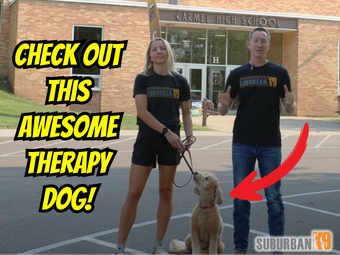Corey is a therapy dog at Carmel High School in Mundelein, IL. Our Madison Territory Manager, Kati, did a fantastic job training Corey, and he is owned by the school principal. This means he gets to go the school as much as he wants! Corey's job is to be a calming influence at the school and to help students enjoy their school day.
Most schools don't have a full time dog for therapy, and Carmel High School is outstanding because of the amount of time and energy they put into this program. Corey walks the halls, goes to yoga class, does random classroom visits, and even goes to pep rallies! We see therapy dogs as a growing trend, and Carmel High School is truly at the forefront of this movement!
What is a Therapy Dog?
A therapy dog is trained to provide comfort and affection to people in various settings. These dogs, known for their gentle demeanor, offer emotional support to individuals in hospitals, schools, and nursing homes. Their presence has been shown to reduce stress and anxiety, promoting a positive atmosphere. They interact with diverse groups, spreading joy and warmth.
Training focuses on obedience, socialization, and calm behavior. Therapy dogs need to be well-mannered and receptive to different people and environments. They create connections, aiding in emotional well-being. In conclusion, therapy dogs play a crucial role in enhancing the lives of those they interact with, proving that a friendly paw and wagging tail can make a significant difference.
Therapy Dog vs. Service Dog; What is the Difference?
A therapy dog's core duty lies in furnishing emotional support and comfort across various contexts. Their aim is to uplift spirits and diminish stress through gentle interactions. Conversely, a service dog undergoes specialized training to aid individuals with disabilities. These canines execute precise tasks to alleviate their handler's limitations. Service dogs undergo intensive training to adapt their skills to unique needs, like guiding the visually impaired or alerting those with hearing impairments.
| Aspect | Therapy Dogs | Service Dogs |
|---|---|---|
| Role | Provide emotional support | Assist individuals with disabilities |
| Primary Purpose | Comfort and reduce stress | Perform specific tasks for their handlers |
| Training Focus | Obedience, socialization | Task-specific training for disabilities |
| Legal Protections | Limited legal access | Legal access to public spaces |
| Interaction | Uplift spirits through comfort | Offer practical assistance |
An important difference emerges in legal protection, where service dogs hold rights to access public spaces, a distinction from therapy dogs. The crux of the matter rests in their roles and training goals. Therapy dogs offer emotional solace, whereas service dogs provide tangible aid to those with disabilities. Both roles contribute positively, albeit via distinct pathways, ultimately enhancing the lives they touch.
Therapy Dog vs. Emotional Support Animal; What is the Difference?
As mentioned earlier, therapy dogs are trained to provide emotional comfort in specific settings, collaborating with handlers to bring solace to individuals. In contrast, an emotional support animal assists those with diagnosed emotional or psychological disorders. Unlike therapy dogs, ESAs offer companionship and symptom alleviation without specialized training.
| Aspect | Therapy Dogs | Emotional Support Animals (ESAs) |
|---|---|---|
| Role | Provide comfort and support to various people | Offer emotional assistance to their owners |
| Training | Extensive training to engage with different groups | No specialized training required |
| Interaction | Work with trained handlers in specific settings | Primarily provide companionship to owners |
| Purpose | Uplift spirits and reduce stress | Alleviate symptoms of emotional disorders |
| Legal Access | Access rights in specific locations | Housing and travel privileges as ESAs |
| Beneficiaries | Various individuals in specific situations | Owners with diagnosed emotional disorders |
While therapy dogs interact widely under trained handlers, ESAs aid their owner's emotional well-being. Legally, therapy dogs access specific locations, while ESAs enjoy housing and travel privileges. Therapy dogs comfort diverse individuals, while ESAs cater to their owner's emotional needs under professional guidance.
Where are Therapy Dogs used?
Suburban K9 presents comprehensive programs tailored to shape your dog into a proficient therapy companion. Our skilled trainers emphasize obedience, sociability, and tranquility, pivotal attributes for therapy dogs.
Our Dog Boot Camp and In-Home programs provide personalized solutions for those seeking to train their dog for therapy work. Crafted for the optimal well-being of both you and your dog, these programs focus on obedience, leash manners, off-leash training, in-home behavior, socialization, and other training objectives.
Although therapy dogs lack the need for specific tasks, their amiability and decorum are paramount. The foundational step in preparing a dog for therapy is the AKC Canine Good Citizen (CGC) Test. Administered by our certified trainers, we excel at readying your dog to successfully navigate this assessment. Your dog's path to becoming a therapy dog is paved with our expert guidance.
Is there Therapy Dog Training Near Me?
Suburban K9 offers many comprehensive programs that can be personalized to guide your dog toward becoming an adept therapy companion. Our experienced trainers ensure obedience, social skills, and a calm demeanor, vital traits for therapy dogs.
If you need help training your dog for this goal, our Dog Boot Camp and In-Home dog training programs are highly customized and designed to give you and your dog the best life possible. We focus on obedience commands, leash walking, off-leash training, in-home behaviors, socializing, and many other training goals.
While therapy dogs aren't required to perform special tasks, they must be friendly and well-mannered. The first step to making a dog a therapy dog is to take the AKC Canine Good Citizen (CGC) Test. Our trainers are all certified to administer this test, so we're experts at training your dog to pass!
See our video below on how to take and easily pass this test.
After taking the CGC test, many people move on to the Therapy Dog International (TDI) Test or join an organization like The Alliance of Therapy Dogs. If you want to make your dog available for therapy, it makes sense to talk to someone at the location you want them to work to determine their testing requirements.
Other Articles You May Enjoy
 |
Should I Crate Train My Puppy
Our crate training article goes over everything you need to know about crating your dog. From sizing to selecting the right crate, this article can help. |
 |
Dakota 283 G3 Kennel Review
If you are looking for something a little bit more traditional than the dog crate furniture featured in this article, check out our review of the Dakota 283 G3. |
The article above contains Affiliate Links from Amazon and other companies. If you visit their site and buy the product, we will get a small commission. Please know that we only recommend products we truly love and would never recommend a product we don't think is incredible. We look at and try hundreds of products before we ever recommend them to our clients!






